Abstract
The correlation between the yellow colour of the skin and serum bilirubin concentration, reserve albumin concentration, and pH was investigated in 76 icteric neonates. Significant linear correlation existed between yellow colour of the skin and serum bilirubin concentration, reciprocal of the reserve albumin concentration, and the squared hydrogen ion concentration. Furthermore, the basic yellowness of the skin at birth correlated linearily with the yellow colour of the skin measured when the child became jaundiced. The results support the proposed hypothesis that bilirubin is transferred from plasma to skin through two different mechanisms: (a) leakage of bilirubin-albumin complexes into extravascular spaces and (b) precipitation of bilirubin acid in phospholipid membranes. The latter mechanism suggests that measurement of the yellow colour of the skin may be a better predictor of brain damage than the serum bilirubin concentration and thus be of clinical utility. Measurement of the yellow colour of the skin as a method of obtaining serum bilirubin concentration is unreliable.
Full text
PDF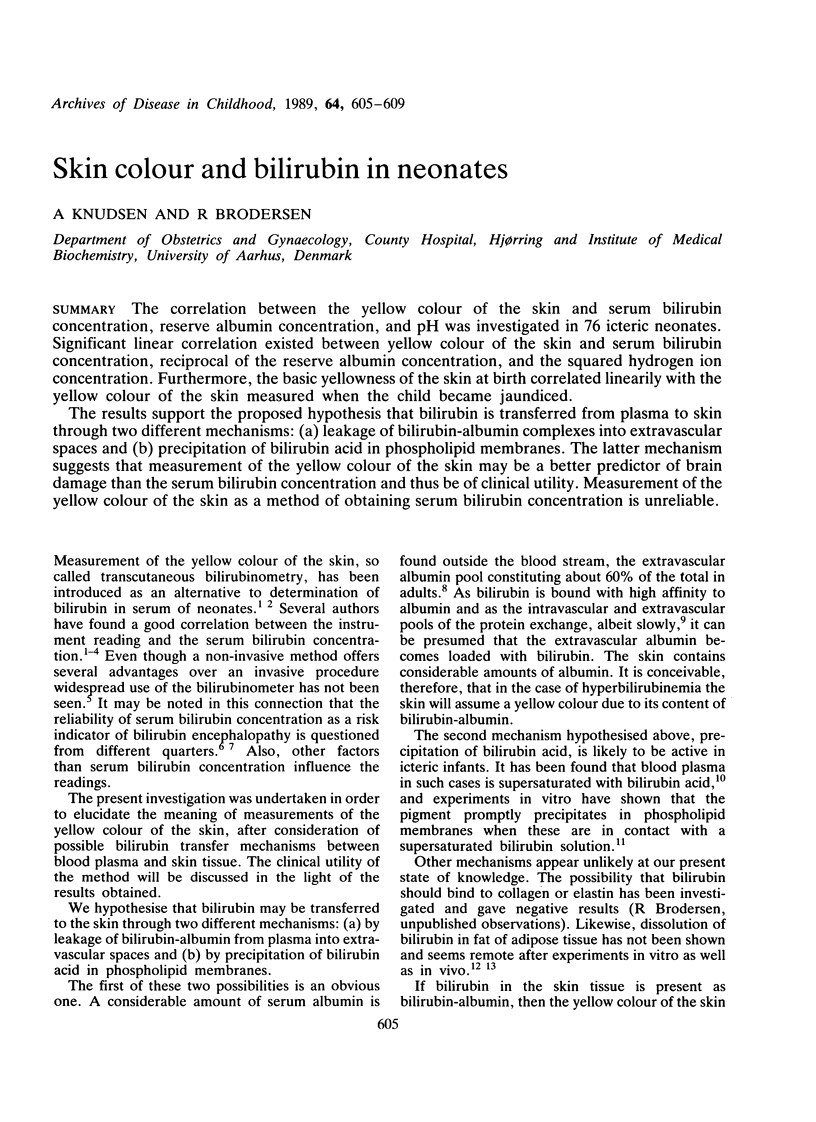
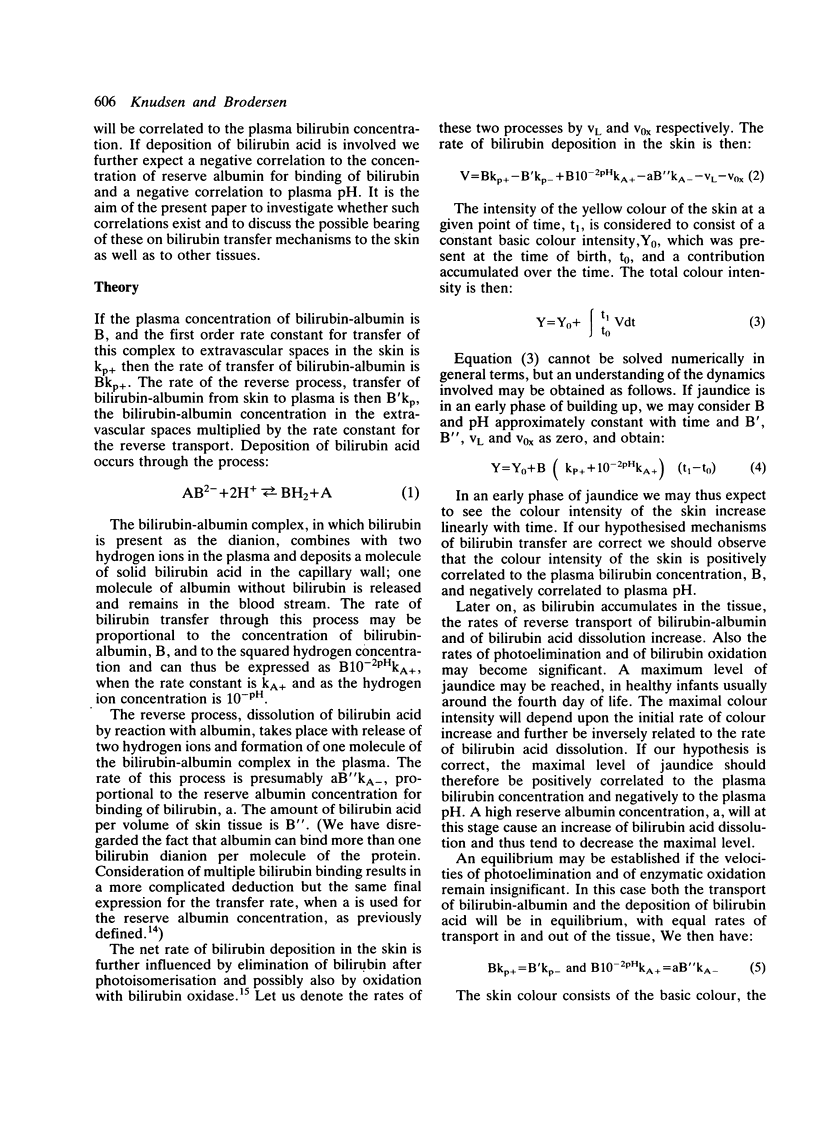
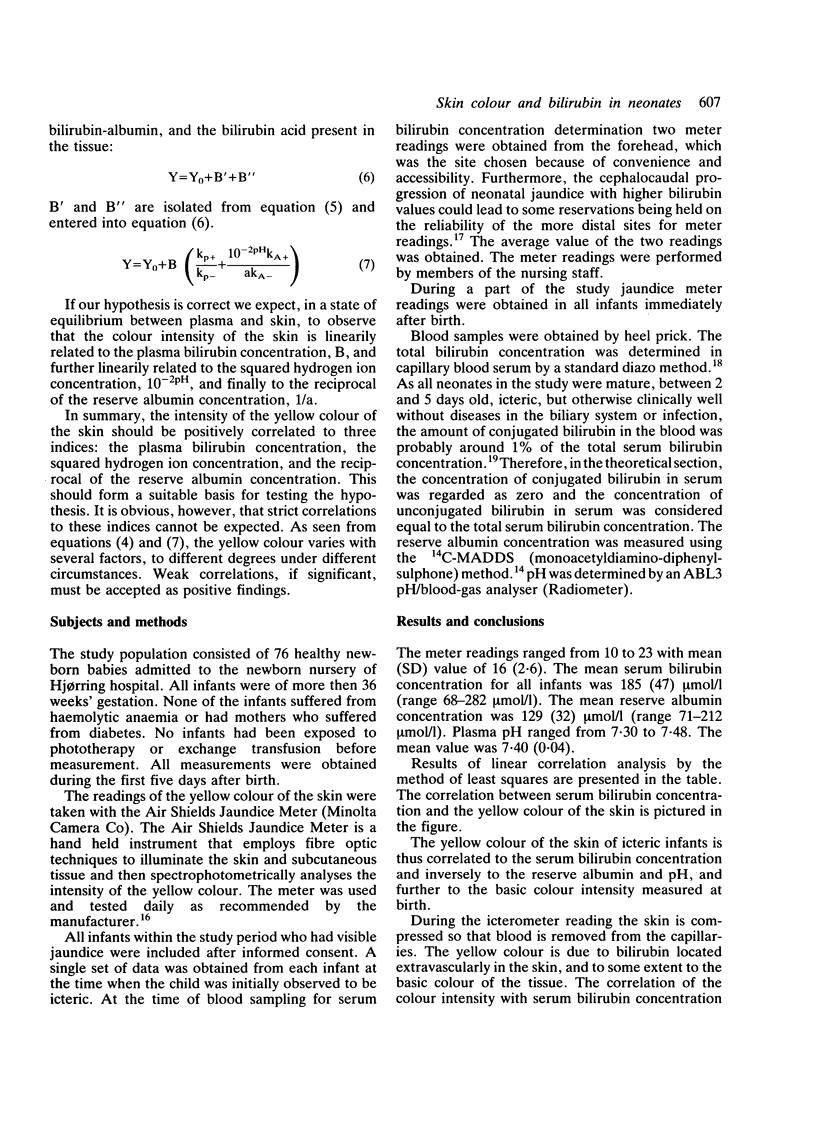
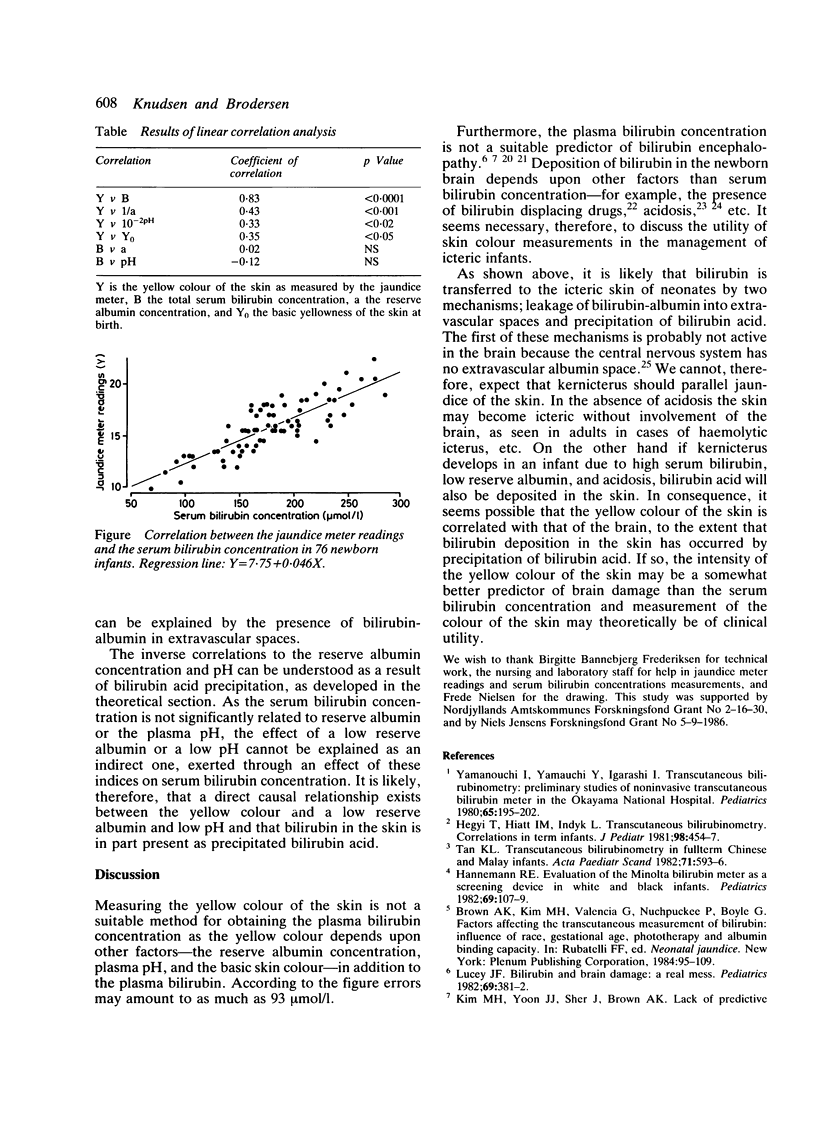
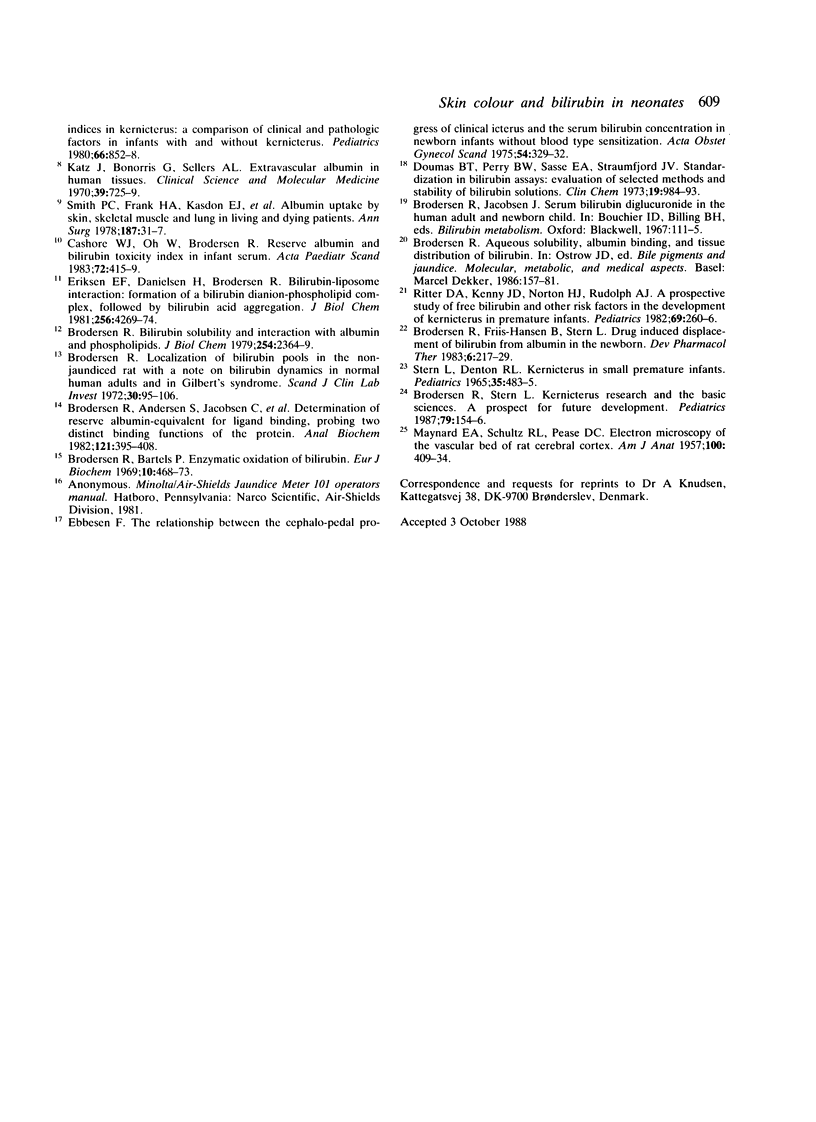
Selected References
These references are in PubMed. This may not be the complete list of references from this article.
- Brodersen R., Andersen S., Jacobsen C., Sønderskov O., Ebbesen F., Cashore W. J., Larsen S. Determination of reserve albumin-equivalent for ligand binding, probing two distinct binding functions of the protein. Anal Biochem. 1982 Apr;121(2):395–408. doi: 10.1016/0003-2697(82)90499-7. [DOI] [PubMed] [Google Scholar]
- Brodersen R., Bartels P. Enzymatic oxidation of bilirubin. Eur J Biochem. 1969 Oct;10(3):468–473. doi: 10.1111/j.1432-1033.1969.tb00712.x. [DOI] [PubMed] [Google Scholar]
- Brodersen R. Bilirubin. Solubility and interaction with albumin and phospholipid. J Biol Chem. 1979 Apr 10;254(7):2364–2369. [PubMed] [Google Scholar]
- Brodersen R., Friis-Hansen B., Stern L. Drug-induced displacement of bilirubin from albumin in the newborn. Dev Pharmacol Ther. 1983;6(4):217–229. doi: 10.1159/000457308. [DOI] [PubMed] [Google Scholar]
- Brodersen R. Localization of bilirubin pools in the non-jaundiced rat, with a note on bilirubin dynamics in normal human adults and in Gilbert's syndrome. Scand J Clin Lab Invest. 1972 Sep;30(1):95–106. doi: 10.3109/00365517209081097. [DOI] [PubMed] [Google Scholar]
- Cashore W. J., Oh W., Brodersen R. Reserve albumin and bilirubin toxicity index in infant serum. Acta Paediatr Scand. 1983 May;72(3):415–419. doi: 10.1111/j.1651-2227.1983.tb09739.x. [DOI] [PubMed] [Google Scholar]
- Doumas B. T., Perry B. W., Sasse E. A., Straumfjord J. V., Jr Standardization in bilirubin assays: evaluation of selected methods and stability of bilirubin solutions. Clin Chem. 1973 Sep;19(9):984–993. [PubMed] [Google Scholar]
- Ebbesen F. The relationship between the cephalo-pedal progress of clinical icterus and the serum bilirubin concentration in newborn infants without blood type sensitization. Acta Obstet Gynecol Scand. 1975;54(4):329–332. doi: 10.3109/00016347509156763. [DOI] [PubMed] [Google Scholar]
- Eriksen E. F., Danielsen H., Brodersen R. Bilirubin-liposome interaction. Binding of bilirubin dianion, protonization, and aggregation of bilirubin acid. J Biol Chem. 1981 May 10;256(9):4269–4274. [PubMed] [Google Scholar]
- Hannemann R. E., Schreiner R. L., DeWitt D. P., Norris S. A., Glick M. R. Evaluation of the Minolta bilirubin meter as a screening device in white and black infants. Pediatrics. 1982 Jan;69(1):107–109. [PubMed] [Google Scholar]
- Hegyi T., Hiatt I. M., Indyk L. Transcutaneous bilirubinometry. I. Correlations in term infants. J Pediatr. 1981 Mar;98(3):454–457. doi: 10.1016/s0022-3476(81)80721-4. [DOI] [PubMed] [Google Scholar]
- Katz J., Bonorris G., Sellers A. L. Extravascular albumin in human tissues. Clin Sci. 1970 Dec;39(6):725–729. doi: 10.1042/cs0390725. [DOI] [PubMed] [Google Scholar]
- Kim M. H., Yoon J. J., Sher J., Brown A. K. Lack of predictive indices in kernicterus: a comparison of clinical and pathologic factors in infants with or without kernicterus. Pediatrics. 1980 Dec;66(6):852–858. [PubMed] [Google Scholar]
- MAYNARD E. A., SCHULTZ R. L., PEASE D. C. Electron microscopy of the vascular bed of rat cerebral cortex. Am J Anat. 1957 May;100(3):409–433. doi: 10.1002/aja.1001000306. [DOI] [PubMed] [Google Scholar]
- Ritter D. A., Kenny J. D., Norton H. J., Rudolph A. J. A prospective study of free bilirubin and other risk factors in the development of kernicterus in premature infants. Pediatrics. 1982 Mar;69(3):260–266. [PubMed] [Google Scholar]
- STERN L., DENTON R. L. KERNICTERUS IN SMALL PREMATURE INFANTS. Pediatrics. 1965 Mar;35:483–485. [PubMed] [Google Scholar]
- Smith P. C., Frank H. A., Kasdon E. J., Dearborn E. C., Skillman J. J. Albumin uptake by skin, skeletal muscle and lung in living and dying patients. Ann Surg. 1978 Jan;187(1):31–37. doi: 10.1097/00000658-197801000-00007. [DOI] [PMC free article] [PubMed] [Google Scholar]
- Stern L., Brodersen R. Kernicterus research and the basic sciences: a prospect for future development. Pediatrics. 1987 Jan;79(1):154–156. [PubMed] [Google Scholar]
- Tan K. L. Transcutaneous bilirubinometry in fullterm Chinese and Malay infants. Acta Paediatr Scand. 1982 Jul;71(4):593–596. doi: 10.1111/j.1651-2227.1982.tb09480.x. [DOI] [PubMed] [Google Scholar]
- Yamanouchi I., Yamauchi Y., Igarashi I. Transcutaneous bilirubinometry: preliminary studies of noninvasive transcutaneous bilirubin meter in the Okayama National Hospital. Pediatrics. 1980 Feb;65(2):195–202. [PubMed] [Google Scholar]


